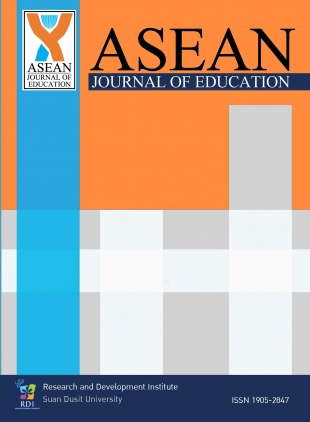Enhancing Students’ Achievement in Descriptive Statistics by Emphasizing Statistical Reasoning
Keywords:
Statistical reasoning, Students’ achievement, Misconceptions in descriptive statisticsAbstract
This study conducted classroom action research as a means to enhance students’ achievement in descriptive statistics by emphasizing statistical reasoning. Statistical reasoning is the method people reason with statistical ideas and make sense of statistical information. In this research, it was categorized into six groups which are reasoning about: (1) data collection, (2) frequency distributions, (3) measures of central tendency, (4) measures of positions, (5) measures of dispersions and (6) standard scores and normal distributions. The participants include 46 Grade 11 students in the first semester of academic year 2018 at a secondary school in Bangkok, Thailand. The topic in this study is descriptive statistics comprising: (1) statistics and data collection, (2) frequency distributions, (3) measures of central tendency, (4) measures of positions, (5) measures of dispersions and (6) standard scores and normal distributions. Instruments in this study consist of 8 lesson plans, achievement test, and reflection form. Teaching and learning lasted for 42 periods each at 50 minutes. This study had three cycles. Each cycle was composed of planning, acting, observing and reflecting. The results show that the effectiveness index is 0.60 which indicates that the students’ achievement was enhanced to the level required by the researcher (accepted effectiveness index must be greater than or equal 0.50). From reflections, the researcher found that using statistical reasoning increases students’ understanding and decreases students’ misconceptions. Statistical misconceptions of students include: misleading graphs, computation of combined means, using inappropriate central tendency, interpretation and properties of central tendency and dispersions.
References
Aczel, A. D., & Sounderpandian, J. (2006). Complete business statistics. Boston: McGraw-Hill/Irwin.
Batanero, C., Tauber, L. M., & Sánchez, V. (2004). Students’ reasoning about the normal distribution. The Challenge of Developing Statistical Literacy, Reasoning and Thinking, 257–276.
Ben-Zvi, D., & Garfield, J. (2006). The challenge of developing statistical literacy, reasoning and thinking. Berlin: Springer Netherland.
Bennett, J. O., Briggs, W. L., & Triola, M. F. (2003). Statistical reasoning for everyday life. Toronto: Pearson/Addison Wesley.
Callingham, R. A. (1997). Teachers’ multimodal functioning in relation to the concept of average. Mathematics Education Research Journal, 9(2), 205–224.
Carr, W., & Kemmis, S. (1983). Becoming critical: Knowing through action research. Vic.: Deakin University.
Chance, B., Mas, R. D., & Garfield, J. (2004). Reasoning about sampling distribitions. The Challenge of Developing Statistical Literacy, Reasoning and Thinking, 295–323.
Dijke-Droogers, M., Drijvers, P., Tolboom, J. (2018). Enhancing statistical literacy. Ireland: HAL Dublin.
Franklin, C., Kader, G., Mewborn, D., Moreno, J., Peck, R., Perry, M., & Scheaffer, R. (2007). Guidelines for assessment and instruction in statistics education (GAISE) Report: A pre-K-12 curriculum framework. Alexandria, Va.: American Statistical Association.
Ganesan, N. K., & Leong, K. E. (2018). Effectiveness of fathom on statistical reasoning among form four students. Retrieved 2019, August 10, from https:// www.researchgate.net/publication/328018530_Effectiveness_of_Fathom_on_Statistical_Reasoning_among_Form_Four_Students
Garfield, J. (2002). The challenge of developing statistical reasoning. Journal of Statistics Education, 10(3), 1-12.
Garfield, J. & Franklin, C. (2011). Assessment of learning, for learning, and as learning in statistics education. In Batanero, C., Burrill, G., & Reading, C. (Eds.). Teaching Statistics in School Mathematics-Challenges for Teaching and Teacher Education: A Joint ICMI/IASE Study New York: Springer.
Garfield, J. & Gal, I. (1999). Teaching and assessing statistical reasoning. In developing mathematical reasoning in grades K-12: 1999 yearbook. Reston, VA: National Council of Teachers of Mathematics.
Grundy, S. (1995). Action research as on-going professional development. Perth, Western Australia: ArtsAccord Affiliation of Arts Educators (WA).
Huff, D., & Geis, I. (1954). How to lie with statistics. New York: Norton.
Hung, C. M., Wah, L. S., Kwong, M. W., & Man, K. P. (2010). 11: Use and misuse of statistics. In New Trend Mathematics (2nd ed.). Hong Kong: Chung Tai Educational Press.
IPST. (2008). The basic education core curriculum B.E. 2551 Mathematics. Bangkok: IPST.
Ismail, Z., & Chan, S. W. (2015, February). Malaysian students' misconceptions about measures of central tendency: An error analysis. In AIP Conference Proceedings, 1643(1), 93-100.
Kemmis, S., & McTaggart, R. (1988). The action research planner. Geelong, Australia: Deakin University.
Kidrakan, P. (2002). Effectiveness index: E.I., educational measurement. Mahasarakham: Mahasarakham University.
Kilpatrick, J., Swafford, J., & Findell, B. (2001). Adding it up: Helping children learn mathematics. Washington, DC: National Academy Press.
Koshy, V. (2005). Action research for improving practice. London, English: Paul Chapman Publishing.
Krulik, S., & Rudnick, J. A. (1993). Reasoning and problem solving: Handbook for elementary school teacher. Boston: Allyn & Bacon.
National Council of Teachers of Mathematics (NCTM). (2000). Principles and standards for school mathematics.
Reston, Va.: NCTM. Piromnok, N. (2016). Problem-based teaching to promote skills in communication and use of information technology by students majoring in information technology. Asean Journal of Education, 2(1), 23–32.
Slauson, L. V. (2008). Students’ conceptual understanding of variability. Retrieved 2019, August 10, from https://iase-web.org/documents/dissertations/08.Slauson.Dissertation.pdf
Zawojewski, J. S., & Shaughnessy, J. M. (2000). Data and chance. In E.A. Silver & P.A. Kenney (Eds.). Results from the seventh mathematics assessment of the national assessment of educational progress. Reston, VA: National Council of Teachers of Mathematics.
Downloads
Published
How to Cite
Issue
Section
License

This work is licensed under a Creative Commons Attribution-NonCommercial-NoDerivatives 4.0 International License.
1 All articles will undergo a formal peer-review. A panel of experts from within or without the university will examine the article; approval from a minimum of two experts is required for publication. Revisions posed by the experts must be completed by the research prior to publication.
2 Once published in the ASEAN Journal of Education, the article becomes intellectual property of Suan Dusit University. Duplication, in full or part, requires permission from Suan Dusit University.
3 Excluding errors incurred during printing, author(s) are responsible for the content of their articles.






